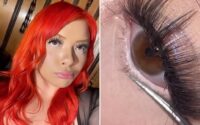Are LED face masks effective and worth the money? Experts discuss
Beloved by beauty experts and celebrities, LED light therapy has been a popular cosmetic treatment to fend off unwanted signs of aging for decades — and is now widely available at home in the form of a glowing red mask or wand for your face.
Starting at about $100 and topping out in the thousands, these tools claim to rejuvenate skin by smoothing fine lines, reducing redness and inflammation, clearing acne, improving elasticity, boosting glow and balancing discoloration.
But are these high-tech products worth their high price tags? A recent report in the Times UK questioned the claims.
Lyma, a brand that boasts at-home light therapy that’s “100x more effective than LED masks,” commissioned researchers at Imperial College London to audit claims made by their competitors. They found these products’ efficacy “highly questionable” and only impacts the “outer layer of the skin, rather than deeper down in the dermis.”
However, advertising officials in the UK recently ruled that Lyma’s claims about their supposedly state-of-the-art cold “laser” are misleading and unsupported by evidence.
“LED masks and other devices have been proven by numerous trials but most importantly by the millions of people who benefit,” Laurence Newman, CEO of beauty tech brand CurrentBody, told The Post. “This recent ‘study’ is not a credible trial or comparison and is full of false claims and misleading comments for commercial gain.”
Meanwhile, widely cited studies previously published in the Journal of the American Academy of Dermatology and the Journal of Clinical and Aesthetic Dermatology have shown measurable benefits to traditional LED therapy.
LED masks and similar products have been on the market and approved by the Food and Drug Administration for decades.
Dr. Henry Legere, the Chief Medical Officer of Restore Hyper Wellness’, a US-based med spa specializing in red light, infrared and cryotherapy, agreed. Legere told The Post that LED masks primarily target the skin’s outermost layer, which comes with some skin benefits.
“At-home devices can be effective,” Legere insisted. “They are useful for maintenance and mild to moderate skin concerns and can help reduce fine lines and wrinkles, improve skin tone and texture, reduce inflammation, and enhance wound healing.”
He said that “for more profound changes, penetration into the dermis is required, which LED masks typically do not achieve.”
Board-certified NYC cosmetic dermatologist Dr. Michele Green explained to The Post, “The depth at which LED penetrates the skin depends on the colors of light emitted, as different colors of light carry different wavelengths.”
“Red light is believed to act upon fibroblasts in the skin to produce collagen. In contrast, blue light is believed to act upon porphyrins to exert a bactericidal effect on acne-causing bacteria. Red light carries a longer wavelength than blue light and has the deepest tissue penetration of most LED wavelengths.”
“While LED masks may only impact the outer layer of skin, it is important first to understand what type of light and wavelengths these masks are using.”
Dr. Maryam Zamani, founder of MZ Skin and leading ocular surgeon, told The Post that different wavelengths of light have their own benefits.
“Blue light is used for acne because it produces the strongest photoactivation of endogenous porphyrins through a process to destroy the P.Acnes, the bacteria known to cause acne,” she said. “When used in combination with red LED light, studies have shown there is even greater efficacy in the treatment of acne.”
And when combined with LED red, “infrared light has also been used to improve the appearance of photoaging skin.”
The risks are typically minimal, including temporary redness, dryness, or irritation, especially for those with sensitive skin.
“I’ve worked with scores of clients who have started to use an LED face mask at home and I’ve seen the change in their skin,” Clinical Aesthetician Pam Marshall, Mortar & Milk, told The Standard.
“Just because an at-home LED doesn’t penetrate as deeply, doesn’t mean it isn’t a really good measure — anyone who says otherwise doesn’t understand the trickle-down effect where making the surface of the skin calm and the barrier healthy positively affects everything underneath.”
“Those masks are the equivalent of micro-dosing.”


